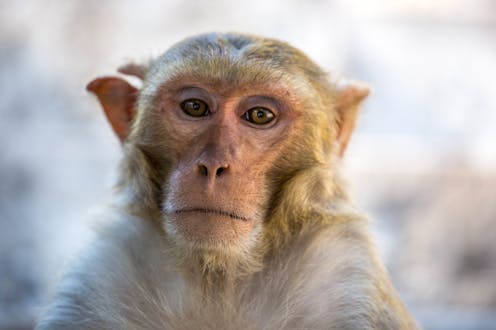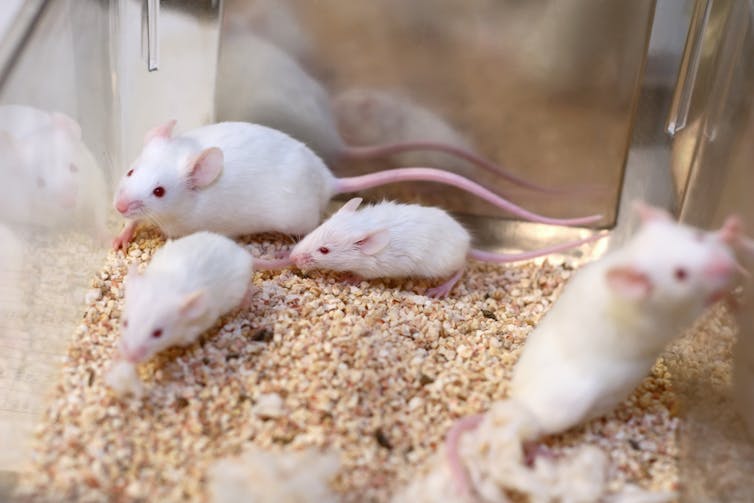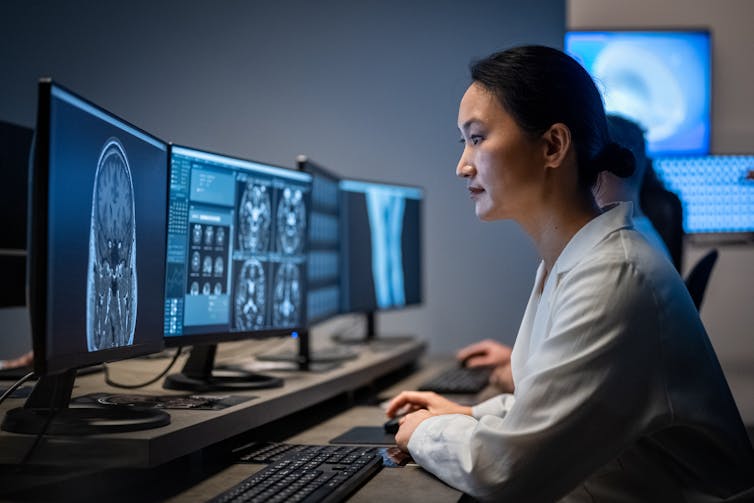Expanding Alzheimer's research with primates could overcome the problem with treatments that show pr
Nonhuman primates like rhesus monkeys share certain characteristics with people that may make them better study subjects than mice for research on neurodegenerative diseases.

As of 2022, an estimated 6.5 million Americans have Alzheimer’s disease, an illness that robs people of their memories, independence and personality, causing suffering to both patients and their families. That number may double by 2060. The U.S. has made considerable investments in Alzheimer’s research, having allocated US$3.5 billion in federal funding this year.
Why, then, are researchers no closer to a cure today than they were 30 years ago?
Back in 1995, researchers created the first transgenic mouse model of Alzheimer’s disease, which involved genetically modifying mice to carry a gene associated with early-onset Alzheimer’s. Myriad studies have since focused on mouse models that accumulate abnormal proteins in their brains, a hallmark of the disease. Although these studies made great strides in understanding specific mechanisms involved in the disease, they have failed to translate into effective treatments.
As research scientists working with nonhuman primates, we believe that part of the problem is that mice don’t reflect the full spectrum of Alzheimer’s disease. A more complementary animal model, however, could help researchers better translate the results from animal studies to humans.
Why animal models?
A critical aspect of understanding what goes awry in Alzheimer’s disease is the relationship between brain and behavior. Researchers rely heavily on animal models to do these types of studies because ethical and practical issues make them impossible to conduct in people.
In recent years, researchers have developed alternative methods to study Alzheimer’s, such as computer models and cell cultures. Although these options show promise for advancing Alzheimer’s research, they don’t supersede the need for animal models because of important limitations.
One is their inability to replicate the complexity of the human brain. The human brain has an estimated 86 billion neurons that perform highly complex computations. While computer models can simulate the workings of specific neural circuits, they are unable to fully capture these complex interactions and work best when used in concert with animal models.
Similarly, cell cultures and brain organoids – miniature brains derived from human stem cells – are unable to adequately mimic the aging process and all the ways the components of the human body interact with one another.
As a result of these limitations, researchers turn to animal models that better reflect human biology and disease processes.
The problem with mice
According to the National Association for Biomedical Research, approximately 95% of lab research conducted in animals in the U.S. is done in mice and rats. Alzheimer’s is no exception: For more than 25 years, research on Alzheimer’s has focused on using transgenic mice to better understand the biological changes associated with the disease.
Because mice do not naturally get Alzheimer’s, they are genetically engineered to develop abnormal proteins known as amyloid plaques and neurofibrillary tau tangles to mimic Alzheimer’s in their brains. These protein accumulations impair brain function and are associated with memory impairment. While studies on treatments that remove these proteins have been able to improve cognition in mice, similar interventions have failed in people.

This highlights the challenge of translating animal research in the lab to people in the clinic. Mouse studies often mirror only a single aspect of the disease that may not be directly relevant to people. For example, most transgenic mouse models focus on amyloid protein buildup while neglecting other crucial aspects of the disease, such as overall neurodegeneration. Such limitations have led some scientists to question the value of using mouse models for Alzheimer’s research.
It is important to recognize, however, that scientific knowledge often advances in incremental steps through the collective results of many studies using different methods and models. Rodent studies provide the necessary foundation for animal models that better mimic the full scope of Alzheimer’s – such as nonhuman primates.
Nonhuman primates offer a closer model
The specific features of a species – including brain structure, cognitive ability, life span and the extent to which they show the hallmarks of Alzheimer’s – determine how suitable it is for specific research questions. Based on these factors, we believe that nonhuman primates are particularly well suited for Alzheimer’s research.
Primates are a diverse group of mammals that includes humans, apes, monkeys and prosimians. Nonhuman primates are particularly valuable for understanding human aging and Alzheimer’s disease because their genetic makeup, brain, behavior, physiology and aging process closely resemble those of people. Aging monkeys experience cognitive, physical and sensory decline as well as a variety of illnesses, such as cancer and cardiovascular disease, much like aging people. Perhaps most critical for Alzheimer’s research, nonhuman primates live much longer than rodents and can naturally develop some of the hallmarks associated with Alzheimer’s as they get older.
Using nonhuman primates in research faces some challenges. Compared to mice, nonhuman primates are more expensive to house and feed, and face a growing shortage in research facilities. Nonhuman primates are also prime targets for activists seeking to stop the use of animals in research. Yet, in light of ongoing failures with rodent models, nonhuman primates could significantly help scientists better understand and treat Alzheimer’s.

Scientists study Alzheimer’s in nonhuman primates in a number of ways.
In one approach, researchers examine species with short life spans, such as gray mouse lemurs or common marmosets, to measure how brain and behavior naturally change with age and identify potential predictors of disease. Other researchers may instead accelerate the disease process by inducing plaque or tangle formation in the brains of longer-lived species, like rhesus macaques. These approaches yield studies that are particularly promising for testing treatments in a short time frame.
A third approach takes advantage of recent advances in genomics to study marmosets born with genetic mutations involved in Alzheimer’s. This method provides the opportunity to test preventive treatments during early life, well before any sign of the disease appears.
Lastly, comparing Alzheimer-like patterns across primate species may help reveal critical risk factors for developing the disease, which could be reduced to promote healthy aging.
We believe that research in nonhuman primates, when conducted with the highest ethical standards, provides the best chance to understand how and why Alzheimer’s disease progresses, and to design treatments that are safe and effective in people.
Agnès Lacreuse receives funding from NIH, serves on the American Psychological Association Committee for Animal Research and Ethics and volunteers for Speaking of Research
Allyson Bennett serves on the Board of Directors for Public Responsibility for Medicine & Research and volunteers for Speaking of Research.
Amanda M. Dettmer does not work for, consult, own shares in or receive funding from any company or organization that would benefit from this article, and has disclosed no relevant affiliations beyond their academic appointment.
Read These Next
The Bible says little about Jesus’ childhood – but that didn’t stop medieval Christians from enjoyin
Legends about Jesus’ early years that circulated in medieval Europe often drew on apocryphal texts.
Sleep problems and depression can be a vicious cycle, especially during pregnancy − here’s why it’s
Inadequate sleep can have negative downstream effects on everyday cognitive functioning and mental health,…
Whether Netflix or Paramount buys Warner Bros., entertainment oligopolies are back – bigger and mor
Hollywood has seen this movie before.






